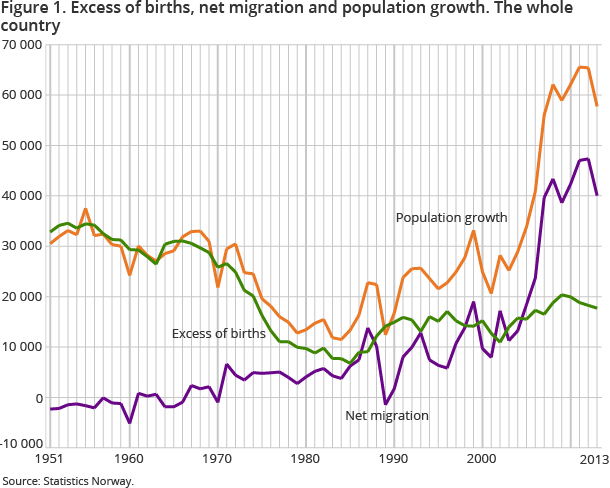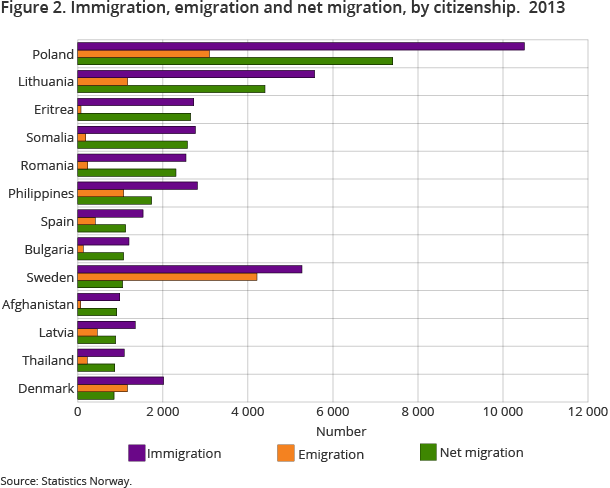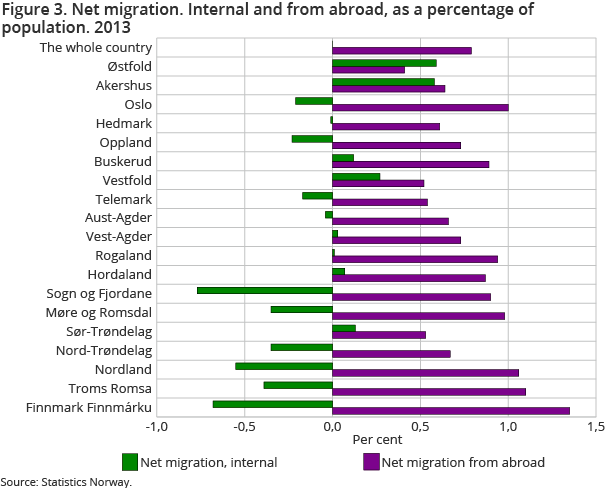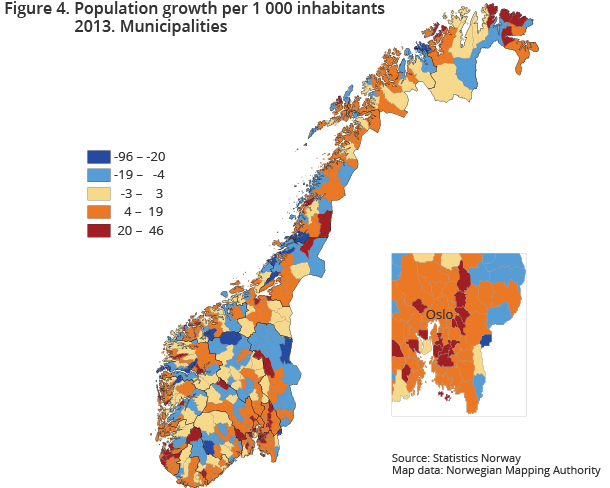Content
Published:
This is an archived release.
Population growth slows slightly
At the beginning of the year, there were 5 109 000 residents in Norway, which gives a population growth of 57 800 in 2013; 7 600 less than in 2012. This is the lowest growth in absolute figures since 2007. Immigration surplus accounted for 69 per cent of the growth.
| 4th quarter 2013 | 4th quarter 2012 - 4th quarter 2013 | ||
|---|---|---|---|
| Number | Per cent | ||
| Population at the beginning of the quarter | 5 096 300 | 58 163 | 1.2 |
| Births | 13 425 | -296 | -2.2 |
| Deaths | 10 462 | -251 | -2.3 |
| Excess of births | 2 963 | -45 | -1.5 |
| Immigration | 17 956 | -660 | -3.5 |
| Emigration | 8 334 | 12 | 0.1 |
| Net migration, immigration and emigration incl | 9 622 | -672 | -6.5 |
| Population growth | 12 756 | -382 | -2.9 |
| Population at the end of the quarter | 5 109 056 | 57 781 | 1.1 |




The population growth was 1.1 per cent in 2013, which is the smallest percentage growth in Norway since 2006. Net migration from abroad decreased by 7 200 from 2012 to 2013 - down from 47 300 to 40 100, and this is the lowest since 2009. Net migration in the last five-year period is still high, at almost 80 000 more than in the previous five-year period. There were 75 800 in-migrations to Norway from abroad in 2013, which was 2 800 fewer than the previous year. A total of 35 700 persons emigrated, which is 4 500 more than last year. Those who are in the country for less than six months are not registered and are therefore not included in these figures.
Much of the out-migration last year is likely to relate to persons who have emigrated some time ago, and have not reported this to the population register. The Tax Administration clears out the Central Population Register on an ongoing basis in order to keep it up-to-date in relation to persons who are no longer living in Norway.
Lower fertility rate, almost unchanged life expectancy
In 2013, 59 000 children were born in Norway, which was about 1 300 fewer than the previous year. A total of 41 300 persons died; 700 fewer than in 2012. The birth surplus was 550 lower in 2013 than in 2012, and was also somewhat lower than recent years. All counties in Norway had a birth surplus, except for Hedmark, Oppland and Telemark, which have all had a birth deficit in recent years. Nordland had a small birth surplus, with just 70 more births than deaths. As in previous years, the birth surplus is highest in Oslo and Akershus (8 100 in total) and Rogaland (5 600). In relation to the population, the birth surplus is clearly highest in Oslo and Rogaland.
The total fertility rate for 2013 was 1.78. The corresponding figure for 2010, 2011 and 2012 was 1.95, 1.88 and 1.85 respectively. Nevertheless, Norway still has one of the highest fertility rates in Europe.
There was a slight increase in life expectancy for men and women. A boy born in 2013 is expected to live to 79.7 years, while a girl can expect 83.6 years. This is only a difference of a few months compared to the previous year.
High, but declining migration from Europe
Net migration of foreign nationals decreased from 48 700 in 2012 to 41 900 in 2013. Of this, 25 800 or 62 per cent of the net immigrants were European citizens. In 2012, the figure was higher, at 30 900. Net migration of non-European citizens declined from 17 800 in 2012 to 16 100 or 38 per cent of the net- migration.
Citizens from nine countries had a net in-migration of more than 1 000, and six of these countries are European. Polish and Lithuanian citizens are clearly still the two largest groups, and together they constituted about half of the European citizens. Labour and family are the main reasons for in-migration. Net migration of Spanish citizens fell from 1 200 in 2012 to 1 100 in 2013, and these made up the seventh largest group. Persons with a refugee background from Eritrea and Somalia accounted for the third and fourth largest groups respectively. Net migration of Swedish citizens decreased from the eleventh largest group in 2012 to the ninth largest in 2013, but net migration was roughly as high. Net migration from Somalia and Eritrea decreased from 5 700 in 2012 to 5 200 in 2013.
Oslo, Akershus and Rogaland have highest population growth
All counties in Norway had a population growth in 2013. Oslo had the highest, with a total of 10 500 persons, or 1.7 per cent, which is about 200 lower than the previous year. Other counties where the population increased rapidly were Akershus and Rogaland. Akershus grew by 9 400 persons and Rogaland by 7 500. The lowest growth was found in Sogn og Fjordane, with about 300 persons, and in Telemark and Oppland, where the population increased by around just 600 persons. In some counties, such as Oslo and Sogn og Fjordane, the growth was more or less equally divided between births and net migration, while net migration counted for 95 per cent of the growth in Østfold and Nordland. In the three counties Hedmark, Oppland and Telemark, with more deaths than births, the net-migration still amounted to a population growth. However, in these counties net-migration constituted 100 per cent of the growth.
Large internal net migration to Akershus and Østfold
All counties in Norway had an internal net migration surplus. The total net migration in 2013 in absolute figures was highest in Akershus, and in per cent the internal net migration was highest in Akershus and Buskerud.
In order to see the differences between the counties, migration can be broken down into two categories - moving from and to abroad and internal migration.
Net migration – in-migration from abroad minus out-migration to abroad - was highest in Oslo, Hordaland and Rogaland in 2013, with 6 200 in Oslo and about 4 300 for each of the two other counties. As a percentage of the population, however, net migration was highest in the three northernmost counties, and highest in Finnmark by 1.3 per cent. These three counties together with Oslo had a net in migration of one per cent or more. Net migration from abroad outweighed the internal net migration and the birth deficit. The population increased in all counties, but without a migration surplus, the population would decrease in 9 of the 19 counties, and mostly in Nordland, Oppland and Sogn and Fjordane.
Eight counties had an internal migration surplus, i.e. more people moved in from other areas of the country than out to other areas of the country. However, one area stood out in particular with a high internal migration; Akershus and Østfold with 5 000 persons combined. These counties, in addition to having their own places of work, have a short commuter distance to Oslo. The other eleven counties had an internal net migration, i.e. more people moved out to other areas of the country than people moving in from other areas of the country. As a percentage, the migration loss was highest in Sogn and Fjordane, while the highest percentage gain was in Østfold.
The statistics is published with Population.
Contact
-
Statistics Norway's Information Centre
E-mail: informasjon@ssb.no
tel.: (+47) 21 09 46 42
